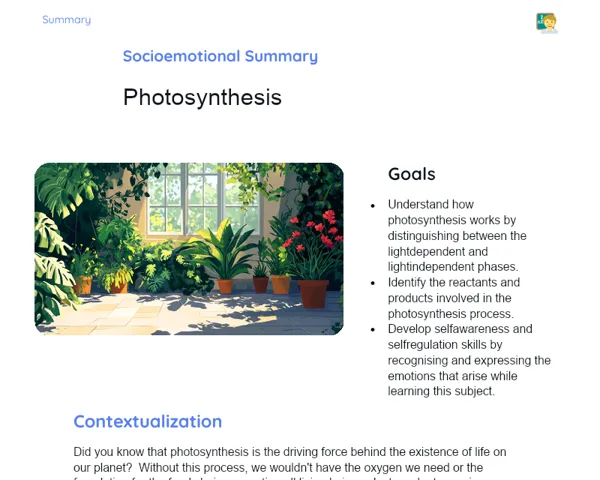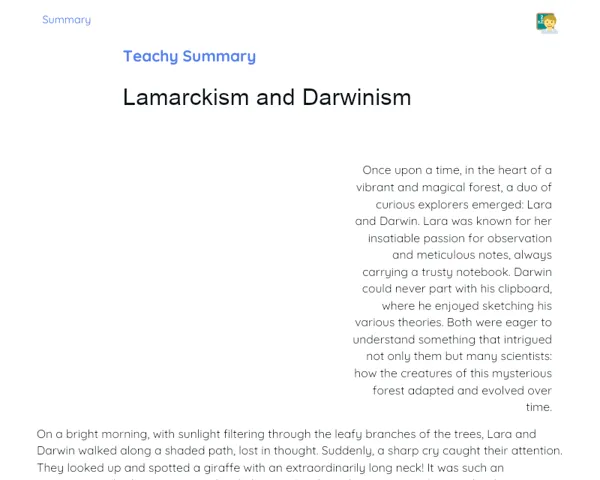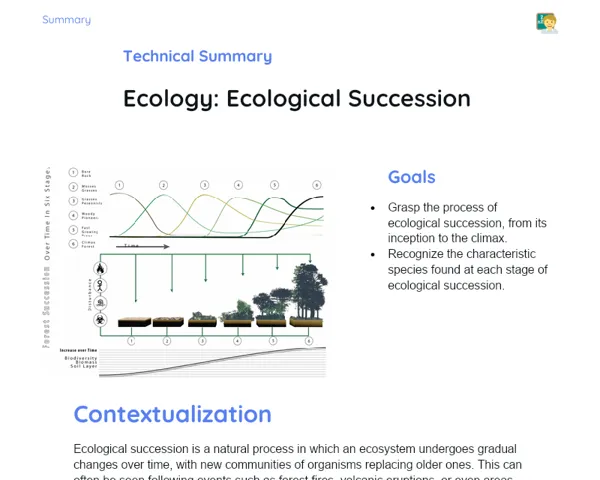Summary Tradisional | Lamarckism and Darwinism
Contextualization
To truly grasp how species evolve, it's important to look at the theories of Lamarck and Darwin. Jean-Baptiste Lamarck, a French naturalist, claimed that traits acquired during an organism's lifetime could not be passed to its offspring. On the other hand, Charles Darwin, a British naturalist, introduced the idea that evolution happens through natural selection. Both these theories were born at a time when the scientific world was buzzing with new discoveries and lively debates, and they have had a lasting impact on modern biology.
Lamarck argued that changes in an organism’s body, brought about by the use or non-use of certain parts, could be inherited. For instance, he believed that giraffes got their long necks because their ancestors stretched to reach high leaves, and this trait was passed on. In contrast, Darwin observed that individuals within a species naturally vary, and that these variations could be beneficial or harmful for survival and reproduction. He famously pointed to the finches of the Galápagos Islands, where different beak types evolved to suit different food sources.
To Remember!
Lamarck's Theory
Jean-Baptiste Lamarck was among the early scientists to propose a systematic theory on the evolution of organisms. He believed that organisms acquired certain characteristics during their lifetime due to the use or disuse of specific body parts, and that these acquired traits couldn’t be passed on to the next generation. This idea is known as the Law of Use and Disuse. For example, Lamarck proposed that giraffes developed long necks because their ancestors stretched in order to reach high leaves. However, with the rise of modern genetics, this idea has been largely disproven.
Lamarck’s theory also introduced the notion that the needs or desires of an organism could direct evolutionary change, meaning that organisms gradually changed over time to better fit their surroundings. While this was an innovative thought, modern scientific evidence does not support it. Advances in genetics have clearly shown that traits acquired during an organism's life are not inherited in the way Lamarck suggested.
Despite its shortcomings, Lamarck’s theory was crucial in paving the way for future discussions and theories on evolution. Its emphasis on the possibility of change and adaptation over time continues to influence evolutionary biology.
-
The Law of Use and Disuse implies that traits gained during an organism's life are not passed on.
-
Lamarck's theory stresses the adaptation of organisms to their surroundings as a key factor in evolution.
-
Modern genetics has refuted the idea that acquired characteristics are inherited.
Darwin's Theory
Charles Darwin put forward the theory of natural selection as the main process behind evolution. According to him, individuals within a species show natural variations in their traits, and these variations can give them either an advantage or disadvantage when it comes to surviving and reproducing. Those with helpful traits are more likely to survive and pass on those traits to the next generation, a concept often summed up as Survival of the Fittest.
Darwin developed these ideas during his journey on the HMS Beagle, where he observed a rich variety of life across different environments. His study of the finches in the Galápagos Islands was especially significant; he noticed that different finch species had beaks suited to different types of food, indicating that natural selection was in play.
This theory was revolutionary because it offered a natural explanation for evolution based on observable and experimental evidence. With further breakthroughs in genetics, Darwin’s ideas have been extensively supported and expanded, forming the cornerstone of modern evolutionary biology. Natural selection remains a key concept to understand evolution and biodiversity even today.
-
Natural selection is the central mechanism of evolution, as per Darwin.
-
Survival of the Fittest highlights that individuals with beneficial traits tend to thrive.
-
Darwin's work on Galápagos finches was instrumental in developing his theory.
Comparison between Lamarckism and Darwinism
While both Lamarck and Darwin offered theories on evolution, their ideas are fundamentally different. Lamarck maintained that traits acquired during an organism’s life would not be inherited by its descendants, whereas Darwin believed evolution occurred through natural selection, with advantageous genetic variations being passed on because they enhanced survival.
Lamarckism suggests that evolution is a directed process driven by the use or non-use of traits, but Darwinism focuses on the importance of natural variation and the selection of traits that help an organism survive. Darwin’s theory is underpinned by genetic and fossil evidence, whereas Lamarck's lacks such empirical support and has been mostly set aside in modern biology.
Recognising these differences is important for a deep understanding of how our knowledge of evolution has evolved over time. Darwin’s ideas have been further refined and enriched with new discoveries, while Lamarckism remains a historically interesting theory that sparked early debates about evolution.
-
Lamarckism postulates the inheritance of acquired characteristics, while Darwinism centers on natural selection.
-
Darwinism is supported by substantial genetic and fossil evidence.
-
Although historically significant, Lamarckism has been discredited by modern research.
Practical Examples
Using practical examples is key to understanding the theories of Lamarck and Darwin. A classic example from Lamarck’s theory is the long necks of giraffes. According to Lamarck, giraffes’ ancestors stretched their necks to reach leaves at great heights, and this trait was then passed down. Even though this idea has been debunked, it provides a useful way to comprehend Lamarck’s line of thought.
For Darwin's theory, the Galápagos finches offer a notable example. Darwin observed that the finches had varied beaks that were adapted to different types of food available on the islands. This demonstrated that natural selection was operating, favouring finches with beaks best suited to their feeding needs. This illustration makes it easier to understand how natural selection leads to adaptation and diversity in species.
Additional examples of natural selection include the growing problem of antibiotic resistance in bacteria and camouflage in various animals. These examples clearly show how environmental pressures can shape and refine traits in populations over time.
-
Giraffes’ long necks are a classic example used in Lamarck’s theory.
-
The adaptation in Galápagos finches is a strong example of Darwin's natural selection.
-
Antibiotic resistance and camouflage are modern-day illustrations of natural selection at work.
Key Terms
-
Lamarckism: The theory proposed by Jean-Baptiste Lamarck that suggests acquired characteristics during an organism's life cannot be inherited.
-
Darwinism: The theory proposed by Charles Darwin that suggests evolution occurs through the process of natural selection.
-
Law of Use and Disuse: Lamarck's concept stating that frequently used parts of the body develop, while those not used tend to waste away.
-
Inheritance of Acquired Characteristics: Lamarck's idea that traits gained over the lifetime of an organism are not passed on to its offspring.
-
Natural Selection: The process described by Darwin where genetic traits that aid survival and reproduction are more likely to be passed to the next generation.
-
Survival of the Fittest: Darwin's concept indicating that individuals with advantageous traits are more likely to survive and multiply.
-
Galápagos Finches: The example Darwin used to illustrate natural selection, where different finch species evolved different beak shapes depending on their food sources.
-
Genetic Variation: The natural differences in DNA among individuals in a population.
-
Scientific Evidence: Data and observations that support a scientific theory, including fossils and genetic studies.
Important Conclusions
In summary, the theories of Lamarck and Darwin are fundamental for understanding the evolution of species. Lamarck argued that traits acquired during an organism's lifetime could not be inherited, while Darwin introduced natural selection, where beneficial genetic variations are passed on to future generations. Both ideas emerged during a period of significant scientific exploration and debate, leaving a lasting influence on modern biology.
Although Lamarck’s theory was quite forward-thinking for its time, advances in genetics have shown that acquired characteristics are not inherited. On the other hand, Darwin’s theory, bolstered by genetic and fossil evidence, forms the basis of modern evolutionary biology. Today, natural selection remains a central concept in biology, explaining how species adapt and diversify over time.
Knowing these theories not only deepens our understanding of evolution but also has practical applications in fields like biodiversity conservation and medicine. For instance, natural selection explains phenomena such as antibiotic resistance and camouflage in animals, highlighting its relevance in both historical and modern contexts.
Study Tips
-
Go through the chapters on evolution in your biology textbooks, paying special attention to the sections on Lamarck and Darwin.
-
Watch documentaries and educational videos about Charles Darwin and his HMS Beagle voyage to get a clearer picture of his observations.
-
Engage in exercises and review questions that focus on the differences between Lamarckism and Darwinism, along with the practical examples discussed in class.



